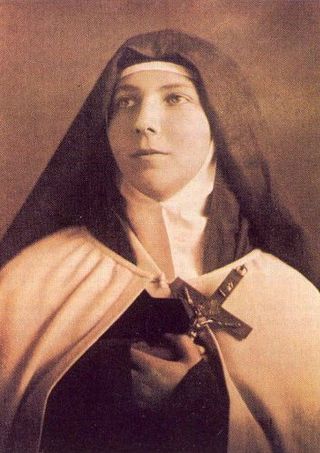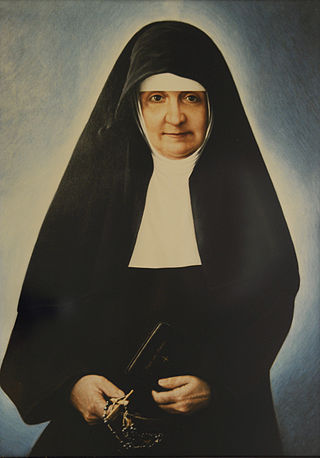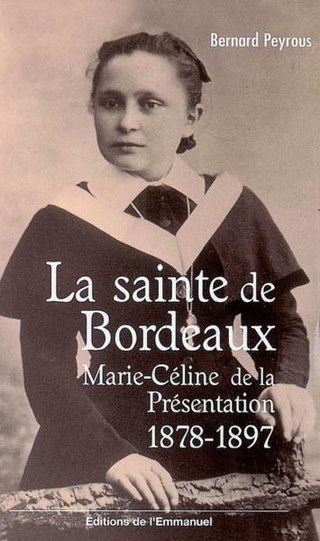
Teresa of Jesus of Los Andes, born as Juana Enriqueta Josephina de Los Sagrados Corazones Fernández Solar, was a Chilean nun of the Discalced Carmelites. Fernández Solar was a pious child but had an often unpredictable temperament for she could be prone to anger and being vain but could also demonstrate her charitable and loving nature; she seemed transformed when she decided to become a nun and her character seemed to change for her sole ambition was to dedicate herself to the service of God. But her time in the convent was cut short due to her contracting an aggressive disease that killed her - she knew she would die but was consoled knowing she would be able to make her profession before she died.

Magdalena di Canossa was an Italian professed religious and foundress of the two Canossian congregations. Magdalena was a leading advocate for the poor in her region after she witnessed first hand the plight of the poor following the spillover effects of the French Revolution into the Italian peninsula through the Napoleonic invasion of the northern territories. Canossa collaborated with humanitarians such as Leopoldina Naudet and Antonio Rosmini in her mission of promoting the needs of the poor and setting a new method of religious life for both men and women.

Zygmunt Gorazdowski was a Polish Roman Catholic priest and the founder of the Sisters of Saint Joseph. Gorazdowski suffered from tuberculosis during his childhood which impeded his studies for the priesthood in what required him to take time off in order to recover before he could be ordained. Once he was ordained he served in various parishes while setting up homes for orphans and single mothers as well as hospices and other establishments for a range of people; he was a prolific writer of catechism and other religious notes for the benefit of his flock.

Marie-Eugénie de Jésus, born Anne-Eugénie Milleret de Brou, was a French religious sister and the foundress of the Religious of the Assumption. Her life was not geared towards faith in her childhood until the reception of her First Communion which seemed to transform her into a pious and discerning individual; she likewise experienced a sudden conversion after hearing a sermon that led her to found an order dedicated to the education of the poor. However, her religious life was not without its own set of trials, for complications prevented her order from receiving full pontifical approval due to a select few causing problems as well as the deaths of many followers from tuberculosis in the beginning of the order's life.

Clelia Barbieri was an Italian Roman Catholic and the founder of the Little Sisters of the Mother of Sorrows. She is regarded as the youngest founder of a religious congregation in the history of the Catholic church, as she was just twenty-three when she died. Barbieri declined the married life in her adolescence – even when pressured – in favor of leading a life dedicated to the needs of others; she served as an educator for a while and joined a religious movement which made her a notable figure in her village.

María Bernarda Bütler, born Verena Bütler, was a Swiss religious sister. She founded the Franciscan Missionary Sisters of Mary Help of Sinners and served in the missions in Ecuador and Colombia. Bütler worked for the care of the poor in these places until her exile from Ecuador and entrance into Colombia where she worked for the remainder of her life. The congregation moved there with her, and continued to expand during her time there until her death.

Cándida María de Jesús, born Juana Josefa Cipitria y Barriola, was a Spanish nun and the founder of the Daughters of Jesus. The order – founded in 1871 – was under Jesuit direction from her spiritual director and was involved with the education of children in Salamanca though expanded during her lifetime.

Teresa Jornet Ibars, also known as Saint Teresa of Jesus, was a Spanish Catholic professed religious and the founder of the Little Sisters of the Abandoned Elderly. Ibars was the great-niece of Francisco Palau and a friend and confidante of Saturnino López Novoa. Her dedication to the old and ill was noted, and her sisters' work in Spain and later abroad.

Giulia Salzano was an Italian Roman Catholic professed religious and the founder of the Catechetical Sisters of the Sacred Heart of Jesus (1905). Salzano served as a teacher prior to becoming a religious and since 1865 worked in Casoria as a teacher for children where she demonstrated herself as an apt catechist and instructor.

Anne-Marie Rivier was a French Catholic nun and the foundress of the Sisters of the Presentation of Mary. Rivier's focus was on education and she opened a school just before the beginning of the French Revolution which saw her school confiscated. The end of the revolution allowed for her to resume her educational inclinations and she also founded her religious order to take care of the education of orphans and other children who needed education.

Jeanne-Germaine Castang – in religious Marie-Céline of the Presentation – was a French Roman Catholic nun from the Poor Clares. Her childhood was marked with lameness and she suffered a noticeable limp for the remainder of her life after contracting the disease in 1882 and an operation for pain relief in 1891. Her desire for the religious life began in her childhood and after being turned from the Sisters of Saint Joseph she managed to be admitted into the Poor Clares where she soon became ill with tuberculosis. She was permitted to make her vows well before the usual time since she was in poor health.

María de las Maravillas de Jesús, OCD, in some contexts known as Maravillas de Jesús, was a Spanish Discalced Carmelite. She founded several houses of her order and even set one up in India after serving a brief exile with other Carmelites due to the outbreak of the Spanish Civil War.

María Guadalupe García Zavala – born Anastasia Guadalupe García Zavala – was a Mexican Roman Catholic religious sister and the co-founder of the Handmaids of Santa Margherita and the Poor. She is also known as "Mother Lupita". At one time, she was engaged to be married but she decided her religious call was too strong for that and she broke off her engagement in order to pursue this call. She dedicated herself to the care of ill people and was noted for her compassion and faith.

María de la Purísima Salvat Romero, born María Isabel Salvat Romero, was a Spanish religious sister of the isters of the Company of the Cross. She assumed the religious name María de la Purísima of the Cross.

Rosa Elena Cornejo Pazmiño, also known by her religious name María Francisca of the Wounds, was an Ecuadorian Roman Catholic religious sister. She established the Franciscan Missionaries of the Immaculata.

Paula Montal Fornés was a Spanish Roman Catholic professed religious and the foundress of the Sisters of the Pious Schools. Montal Fornés dedicated her religious career to serving as an educator in Barcelona where she founded schools for people in the area. The death of her father when she was ten forced her to help her mother raise her siblings though was free to pursue her religious inclinations once this was achieved; she and a close friend began setting up a series of schools before formalizing her idea for the establishment of a religious congregation that would be based on education and the establishment of additional schools nationwide.

Giuditta Vannini – also known as Giuseppina – was an Italian Roman Catholic nun who became a Camillian. Together with Luigi Tezza she established the religious congregation known as the Daughters of Saint Camillus. She and her two siblings were orphaned as children and were placed in different homes; she was raised and educated in Rome under nuns where her vocation to the religious life was strengthened. Vannini later tried joining a religious order but was forced to leave during her novitiate period after suffering from ill health. She and Tezza met in 1891 and founded a religious congregation of which Vannini served as Superior General until her death while Tezza was exiled to Peru around 1900.

Helena Stollenwerk, SSpS was a German Catholic religious sister who collaborated with Arnold Janssen and Hendrina Stenmanns and co-founded the Missionary Sisters Servants of the Holy Spirit.

Maria Teresa Merlo – in religious life "Tecla" – was an Italian Roman Catholic professed religious and the co-founder of the Daughters of Saint Paul that she established alongside Blessed Giacomo Alberione. Merlo was an indefatigable writer and traveler as she penned articles for her order and made visits across the world to communities that were established in nations such as the United States of America and Australia.

Agostina Camozzi - in religious Cristina - was an Italian Roman Catholic professed religious from the Order of Saint Augustine. Camozzi led a dissolute life as a widow and a soldier's mistress before she became a nun and adopted a life of total repentance.





















